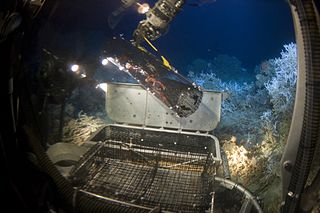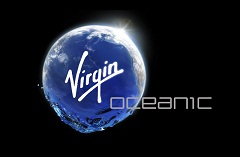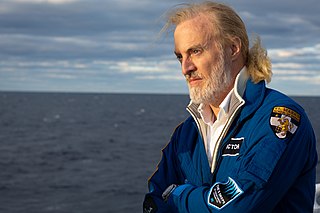 | |
| Founded | 1992 |
|---|---|
| Founder | Sylvia Earle |
| Headquarters | |
Key people |
|
| Website | doermarine |
DOER Marine (Deep Ocean Exploration and Research) [1] is a marine technology company established in 1992 by oceanographer Sylvia Earle, based in Alameda, California.
 | |
| Founded | 1992 |
|---|---|
| Founder | Sylvia Earle |
| Headquarters | |
Key people |
|
| Website | doermarine |
DOER Marine (Deep Ocean Exploration and Research) [1] is a marine technology company established in 1992 by oceanographer Sylvia Earle, based in Alameda, California.

Earle and submersible designer Graham Hawkes founded Deep Ocean Engineering (DOE) in 1982; [2] DOE's products included Phantom, an uncrewed submersible, Deep Rover, a one-person submersible which set a record for deepest solo dive at 1,000 m (3,300 ft), and Deep Flight, designed to descend faster than previous deep-diving submersibles. [3] Later, she left DOE to become the chief scientist at the National Oceanographic and Atmospheric Administration (NOAA) in 1991. [3] Hawkes left DOE and founded Hawkes Ocean Technologies in 1996 to further explore the concepts advanced by Deep Flight. [4]
Earle left NOAA at about the same time DOER was founded in 1992; she intended to continue work on the Ocean Everest project, [5] which she had started with Hawkes at DOE; Ocean Everest aimed to descend to Challenger Deep in the Mariana Trench using the planned Deep Flight-2 crewed submersible. [6] DOER Marine was established in 1992, [7] which specializes in crewed and robotic submersibles, performing design, operation, support, and consulting. [8]
After Earle became the Explorer in Residence at the National Geographic Society in 1995, corporate management was assumed by Earle's daughter, Liz Taylor (President / CEO), [9] [10] supported by Ian Griffith (Director of Marine Operations) and Tony Lawson (Director of Engineering). The company moved into Hangar 41 of the former Naval Air Station Alameda in 2003. [1]
While he was at DOE, Hawkes had built two prototype Deep Flight-1 submersibles, [6] although finding funding for these was challenging. [11] : 147 An earlier concept for an Ocean Everest submersible included a two-person crew and a carbon fiber hull; DOE stated they intended to have it certified by the American Bureau of Shipping with a pressure rating of 30,000 psi (210 MPa; 2,000 atm), giving it a 2:1 factor of safety. [12]
DOER worked with Nuytco Research and the National Geographic Society for the Sustainable Seas Expeditions, which were undertaken between 1997 and 2002. DOER provided training for pilots of the Nuytco Deep Worker and DOE Deep Rover submersibles. [13] David Riordan visited DOER in 2003, asking how he could raise awareness of the ocean's declining fish populations; together with Earle, they devised Project Deepsearch, which would raise funds to develop new submersibles capable of descending to the full depth of the ocean by selling video games, films, and other media. [13]
The resulting Deepsearch crewed submersible was among the competitors to return to Challenger Deep, developed by DOER with financial support from Google's Eric Schmidt. [14] [15] Other competitors included Steve Fossett (with DeepFlight Challenger , backed by Richard Branson's Virgin Group), James Cameron (who would eventually claim the X Prize in 2012 with Deepsea Challenger ), [16] and Triton Submarines (with Triton). [17] DOER built the manipulator arm for Deepsea Challenger and tested its lower hull. [18]
Deepsearch was intended to carry a crew of two or three; like the prior Deep Flight prototypes, it was designed to be positively buoyant, with flow over winglets providing descending force, [11] : 146–147 allowing it to reach the bottom in 90 minutes. [14] [19] [20] In addition to the hydrodynamic winglets, DOER was investigating the use of a thick glass spherical pressure hull and floatation using packed ceramic spheres rather than syntactic foam. [13] Deepsearch was undergoing scale model testing when Schmidt pulled his funding in 2009 and the project was suspended. [21]
A complimentary submersible named Ocean Explorer was being developed at the same time as Deepsearch, designed to replace lockout diving functionality lost after the Johnson Sea Link submersibles retired. Ocean Explorer had a targeted maximum depth of 5,000 m (16,000 ft) [14]
DOER also has developed several remotely operated underwater vehicles (ROVs), including H6500, [22] which later was developed by Pelagic Research Services into ROV Odysseus 6K.
In 2009, DOER coordinated efforts from multiple agencies supplying underwater map data, resulting in the Ocean module of Google Earth, released in version 5.0. [23]

The Challenger Deep is the deepest known point of the seabed of Earth, located in the western Pacific Ocean at the southern end of the Mariana Trench, in the ocean territory of the Federated States of Micronesia. According to the GEBCO Gazetteer of Undersea Feature Names the depression's depth is 10,920 ± 10 m (35,827 ± 33 ft) at 11°22.4′N142°35.5′E, although its exact geodetic location remains inconclusive and its depth has been measured at 10,902–10,929 m (35,768–35,856 ft) by deep-diving submersibles, remotely operated underwater vehicles, benthic landers, and sonar bathymetry. The differences in depth estimates and their geodetic positions are scientifically explainable by the difficulty of researching such deep locations.

The Mariana Trench is an oceanic trench located in the western Pacific Ocean, about 200 kilometres (124 mi) east of the Mariana Islands; it is the deepest oceanic trench on Earth. It is crescent-shaped and measures about 2,550 km (1,580 mi) in length and 69 km (43 mi) in width. The maximum known depth is 10,984 ± 25 metres at the southern end of a small slot-shaped valley in its floor known as the Challenger Deep. The deepest point of the trench is more than 2 km (1.2 mi) farther from sea level than the peak of Mount Everest.

Alvin (DSV-2) is a crewed deep-ocean research submersible owned by the United States Navy and operated by the Woods Hole Oceanographic Institution (WHOI) in Woods Hole, Massachusetts. The original vehicle was built by General Mills' Electronics Group in Minneapolis, Minnesota. Named to honor the prime mover and creative inspiration for the vehicle, Allyn Vine, Alvin was commissioned on June 5, 1964. The submersible is launched from the deep submergence support vessel RV Atlantis (AGOR-25), which is also owned by the U.S. Navy and operated by WHOI. The submersible has made more than 5,200 dives, carrying two scientists and a pilot, observing the lifeforms that must cope with super-pressures and move about in total darkness, as well as exploring the wreck of Titanic. Research conducted by Alvin has been featured in nearly 2,000 scientific papers.

A remotely operated underwater vehicle (ROUV) or remotely operated vehicle (ROV) is a free-swimming submersible craft used to perform underwater observation, inspection and physical tasks such as valve operations, hydraulic functions and other general tasks within the subsea oil and gas industry, military, scientific and other applications. ROVs can also carry tooling packages for undertaking specific tasks such as pull-in and connection of flexible flowlines and umbilicals, and component replacement.
An underwater environment is a environment of, and immersed in, liquid water in a natural or artificial feature, such as an ocean, sea, lake, pond, reservoir, river, canal, or aquifer. Some characteristics of the underwater environment are universal, but many depend on the local situation.

Dr. Sylvia Alice Earle is an American marine biologist, oceanographer, explorer, author, and lecturer. She has been a National Geographic Explorer at Large since 1998. Earle was the first female chief scientist of the U.S. National Oceanic and Atmospheric Administration, and was named by Time Magazine as its first Hero for the Planet in 1998.

A submersible is an underwater vehicle which needs to be transported and supported by a larger watercraft or platform. This distinguishes submersibles from submarines, which are self-supporting and capable of prolonged independent operation at sea.

Don Walsh was an American oceanographer, explorer and marine policy specialist. He and Jacques Piccard were aboard the bathyscaphe Trieste when it made a record maximum descent into the Challenger Deep on January 23, 1960, the deepest point of the world's oceans. The depth was measured at 35,813 feet (10,916 m), but later and more accurate measurements have measured it at 35,798 feet (10,911 m).

A deep-submergence vehicle (DSV) is a deep-diving crewed submersible that is self-propelled. Several navies operate vehicles that can be accurately described as DSVs. DSVs are commonly divided into two types: research DSVs, which are used for exploration and surveying, and DSRVs, which are intended to be used for rescuing the crew of a sunken navy submarine, clandestine (espionage) missions, or both. DSRVs are equipped with docking chambers to allow personnel ingress and egress via a manhole.

Kaikō was a remotely operated underwater vehicle (ROV) built by the Japan Agency for Marine-Earth Science and Technology (JAMSTEC) for exploration of the deep sea. Kaikō was the second of only five vessels ever to reach the bottom of the Challenger Deep, as of 2019. Between 1995 and 2003, this 10.6 ton unmanned submersible conducted more than 250 dives, collecting 350 biological species, some of which could prove to be useful in medical and industrial applications. On 29 May 2003, Kaikō was lost at sea off the coast of Shikoku Island during Typhoon Chan-Hom, when a secondary cable connecting it to its launcher at the ocean surface broke.

Deep-sea exploration is the investigation of physical, chemical, and biological conditions on the ocean waters and sea bed beyond the continental shelf, for scientific or commercial purposes. Deep-sea exploration is an aspect of underwater exploration and is considered a relatively recent human activity compared to the other areas of geophysical research, as the deeper depths of the sea have been investigated only during comparatively recent years. The ocean depths still remain a largely unexplored part of the Earth, and form a relatively undiscovered domain.

Nereus was a hybrid uncrewed autonomous underwater vehicle built by the Woods Hole Oceanographic Institution (WHOI). Constructed as a research vehicle to operate at depths of up to 11,000 metres (36,000 ft), it was designed to explore Challenger Deep, the deepest surveyed point in the global ocean. Nereus, named for Greek sea titan Nereus through a nationwide contest of high school and college students, began its deep sea voyage to Challenger Deep in May 2009 and reached the bottom on May 31, 2009.

Virgin Oceanic is an undersea leisure venture of Newport Beach, CA businessman Chris Welsh and Sir Richard Branson, part of Sir Richard Branson's Virgin Group. The brand was first reported in a 2009 Time Magazine interview. The flagship service provided by Virgin Oceanic was intended to take visitors to the deepest parts of the ocean; however, as of late 2014, the project has been put on hold until more suitable technologies are developed.
ABISMO is a remotely operated underwater vehicle (ROV) built by the Japan Agency for Marine-Earth Science and Technology (JAMSTEC) for exploration of the deep sea. It is the only remaining ROV rated to 11,000-meters, ABISMO is intended to be the permanent replacement for Kaikō, a ROV that was lost at sea in 2003.
Hawkes Ocean Technologies is a marine engineering firm that specializes in consumer submarines, founded by Graham Hawkes. It is headquartered in San Francisco, US.

Graham Hawkes is a London-born marine engineer and submarine designer. Through the 1980s and 1990s, Hawkes designed 70% of the crewed submersibles produced in those two decades. As late as 2007, he held the world solo dive record of 910 metres (2,990 ft) in the submarine Deep Rover.

Deepsea Challenger is a 7.3-metre (24 ft) deep-diving submersible designed to reach the bottom of the Challenger Deep, the deepest-known point on Earth. On 26 March 2012, Canadian film director James Cameron piloted the craft to accomplish this goal in the second crewed dive reaching the Challenger Deep. Built in Sydney, Australia, by the research and design company Acheron Project Pty Ltd, Deepsea Challenger includes scientific sampling equipment and high-definition 3-D cameras; it reached the ocean's deepest point after two hours and 36 minutes of descent from the surface.
DeepFlight Challenger is a one-person submersible built with the intention of reaching the Challenger Deep, utilizing DeepFlight technology from Hawkes Ocean Technologies. The submersible is owned by Virgin Oceanic.

Victor Lance Vescovo is an American private equity investor, retired naval officer, sub-orbital spaceflight participant, and undersea explorer. He was a co-founder and managing partner of private equity company Insight Equity Holdings from 2000-2023. Vescovo achieved the Explorers Grand Slam by reaching the North and South Poles and climbing the Seven Summits, and he then visited the deepest points of all of Earth's five oceans during the Five Deeps Expedition of 2018–2019.

Underwater exploration is the exploration of any underwater environment, either by direct observation by the explorer, or by remote observation and measurement under the direction of the investigators. Systematic, targeted exploration is the most effective method to increase understanding of the ocean and other underwater regions, so they can be effectively managed, conserved, regulated, and their resources discovered, accessed, and used. Less than 10% of the ocean has been mapped in any detail, less has been visually observed, and the total diversity of life and distribution of populations is similarly obscure.
In 1992, Earle returned to private life and a project called Ocean Everest, which she and Hawkes had started. The goal of the project is to visit [Challenger Deep,] the deepest spot in the world's oceans—the underwater equivalent of climbing Mount Everest.
DOER's project was not about one man's quest to race to the bottom of the trench, but to replace a 50-year-old submersible called Alvin used by scientific researchers. The Deepsearch project got to the scale testing stage before funding was pulled by the Marine Science and Technology Foundation, whose president is Eric Schmidt, the former chief executive of Google. [...] Deepsearch would be floated using modern syntactic foam or a matrix of fist-size ceramic spheres filled with air. But the decision on the use of flotation materials was never made as the project lost its funding in 2009.